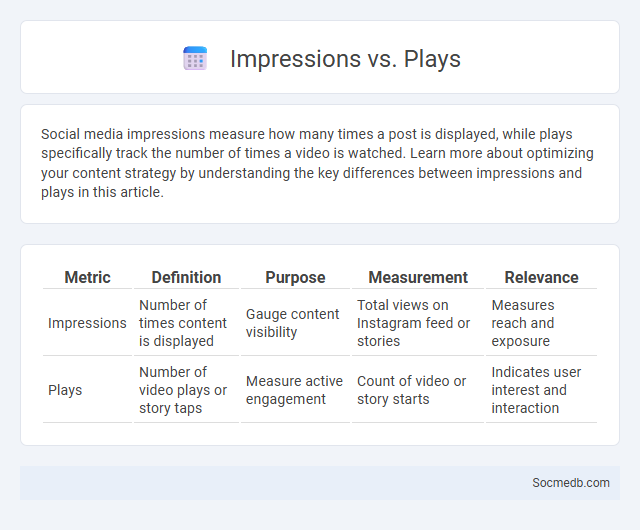
Photo illustration: Impressions vs Plays
Social media impressions measure how many times a post is displayed, while plays specifically track the number of times a video is watched. Learn more about optimizing your content strategy by understanding the key differences between impressions and plays in this article.
Table of Comparison
| Metric | Definition | Purpose | Measurement | Relevance |
|---|---|---|---|---|
| Impressions | Number of times content is displayed | Gauge content visibility | Total views on Instagram feed or stories | Measures reach and exposure |
| Plays | Number of video plays or story taps | Measure active engagement | Count of video or story starts | Indicates user interest and interaction |
Understanding Impressions: What Counts as an Impression?
An impression on social media refers to the number of times your content is displayed on a user's screen, regardless of whether it is clicked or engaged with. This metric helps you gauge the visibility and reach of your posts across platforms like Instagram, Facebook, and Twitter. Understanding impressions allows you to measure how many times your message potentially influences your target audience.
Defining Plays: How Are Plays Measured Online?
Plays on social media are measured by tracking the number of times a video or audio content is initiated by users, often recorded as "views" or "plays." Platforms use metrics such as play count, play rate, and completion rate to assess engagement and content performance. Advanced analytics also consider factors like unique plays, average watch time, and viewer retention to provide a comprehensive understanding of audience interaction.
Impressions vs Plays: Key Differences
Impressions measure the total number of times social media content is displayed, offering insight into reach and visibility, while plays specifically track the number of times a video is actively watched, reflecting audience engagement. Impressions help gauge brand awareness by showing how many users have seen the content, whereas plays indicate content effectiveness in capturing viewer interest. Understanding the distinction between impressions and plays is crucial for optimizing social media strategies and evaluating campaign performance accurately.
The Importance of Tracking Impressions
Tracking impressions on social media provides critical insights into your content's reach and visibility, enabling you to measure how many users have seen your posts. Understanding impression data helps optimize your marketing strategy by identifying high-performing content and audience engagement patterns. You can leverage this information to improve brand awareness and maximize the impact of your social media campaigns.
Evaluating Engagement: The Role of Plays
Evaluating engagement on social media requires analyzing the number of plays your content receives, as plays indicate how often users actively choose to view videos or audio posts. Plays provide valuable insights into audience interest and content effectiveness, helping you refine your strategy for greater reach and interaction. Tracking these metrics allows for better understanding of user behavior and optimizing future posts to boost overall engagement.
Why Distinguish Between Impressions and Plays?
Distinguishing between impressions and plays is crucial for accurately measuring social media engagement and campaign effectiveness. Impressions represent the total number of times content is displayed, providing insight into reach, while plays indicate actual user interaction with video or audio content, reflecting deeper engagement. This differentiation allows marketers to optimize strategies by focusing on not just visibility but meaningful audience participation.
When Impressions Matter More Than Plays
When impressions matter more than plays, your social media strategy should prioritize visibility and brand awareness over direct engagement metrics. High impression counts signal that content is reaching a wide audience, boosting your brand's presence and potential influence. Optimizing posts for shareability and using targeting tools can maximize your content's exposure, ensuring your message resonates even if users don't immediately interact.
Measuring Success: Which Metric Should You Prioritize?
Engagement rate, including likes, comments, and shares, serves as the most reliable metric for measuring social media success because it directly reflects audience interaction and content resonance. Tracking follower growth offers insight into expanding brand reach but may not indicate active engagement. Prioritizing conversion rates, such as click-throughs and sales generated from social media, aligns success measurement with tangible business outcomes.
Optimizing Campaigns with Impressions and Plays Data
Optimizing social media campaigns relies heavily on analyzing impressions and plays data to enhance audience engagement and ad performance. By evaluating impression counts alongside play rates, marketers can identify content that resonates effectively and adjust targeting strategies for higher conversion rates. Leveraging detailed analytics on impressions and plays enables precision in budget allocation and creative optimization, driving measurable campaign success.
Impressions and Plays in Digital Marketing Strategy
Impressions measure how often content appears in users' feeds, playing a crucial role in brand awareness within digital marketing strategies. Plays indicate the actual engagement with video content, reflecting audience interest and content effectiveness. Tracking and analyzing both metrics helps optimize social media campaigns for higher reach and user interaction.
 socmedb.com
socmedb.com